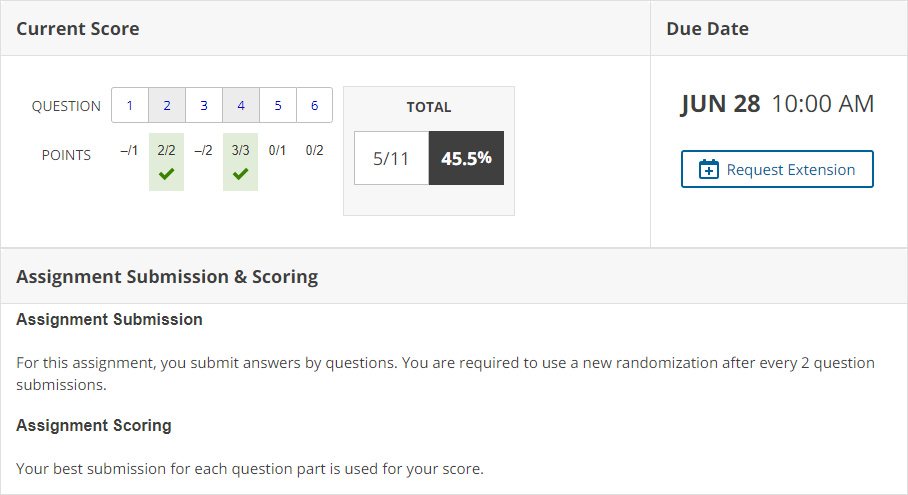Most questions in WebAssign use randomized values, and these values are usually displayed in red. Randomizing question values helps give every student a fair opportunity to succeed on coursework, and it allows for practicing alternative versions of the question if enabled.

The numbers 11 and 28 in this question are randomized.
Depending on the assignment, randomized values are different for each class or for each student. In addition, some assignments require you to request a new randomization after a specified number of submissions.
Assignments Requiring New Randomizations
The Assignment Submission rule at the top of the assignment indicates if your instructor enabled new randomizations for your assignment and how many submissions you must use before requesting a new randomization.

This feature lets you try a different version of the question if you can't answer correctly before a new randomization is required. If enabled by your instructor, you might be shown the answer key or worked solution for a problem after you have used all your submissions for a particular randomization.
How new randomizations work depends on the Assignment Submission rule for the assignment.
| Assignment Submission Rule | New Randomization Behaviors |
|---|---|
| For this assignment, you submit answers by question parts | New randomization is not available. |
| For this assignment, you submit answers by questions | After every n submissions for a question, a
New Randomization button is displayed at the end
of the question and you can't make any more submissions for the question.
|
| For this assignment, you submit the entire assignment | After every n submissions for an assignment, a
New Randomization button is displayed at the end
of the assignment and you can't make any more submissions for the assignment.
|
- The number of attempts you can make between requesting a new randomization is set by your instructor and displayed in the Assignment Submission rule.
- You can't request a new randomization before making the specified number of attempts.
- You can't request a new randomization if you have used all your submissions for the question or assignment.
- Questions that don't have randomized values won't change after requesting a new randomization.
- You don't have to click New Randomization if you are satisfied with your current score for the question or assignment.
- Using new randomizations doesn't change the overall number of submissions allowed for the question or assignment.
Example
For this assignment, you submit answers by questions. You are required to use a new randomization after every 2 question submissions.
- You submit an incorrect answer to question 1.
- After you submit a second answer, the New Randomization button is shown for question 1.
- Because your second answer is still not correct, you click New Randomization to try question 1 with different values.
- You attempt to answer question 1 with the new values (3rd submission).
- After your next attempt to answer question 1 (4th submission), the New Randomization button is shown again.
- Clicking New Randomization gives you one more chance (your 5th submission) to answer the question with yet another set of values.